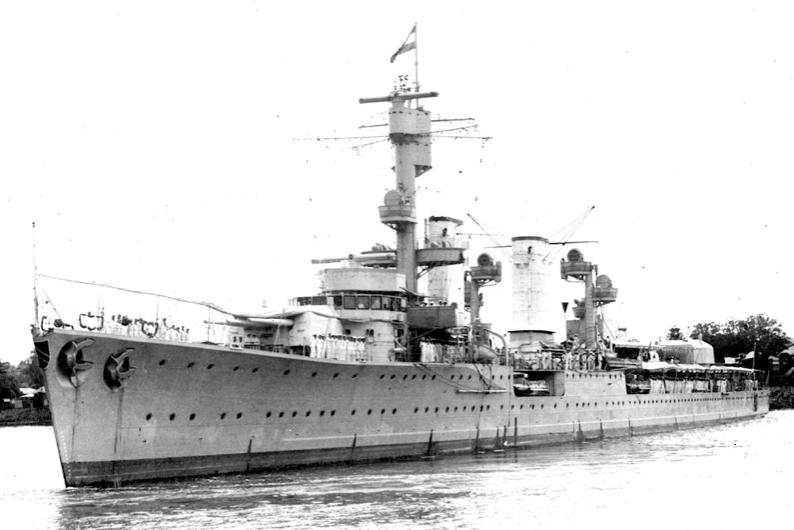
Marburg History
GERMAN SAILORS VISIT MARBURG & BOONAH
One of Germany’s most modern warships, the German Cruiser “Karlsruhe”, reached Brisbane on 18th January 1934 after a journey from Sourabaya, Java. It was the first and only Australian port at which she called on her informal visit. There were 100 especially selected naval cadets on board who were training to become officers. The ship was on a voyage around the world. Its purpose was chiefly for the cadets’ training and instruction. 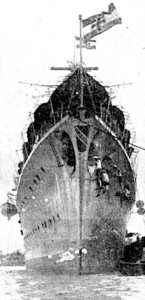
There were mixed feelings concerning the cruiser’s visit amongst the Queensland population given that the previous generation had fought in the Great War against Germany. Yet the visit was interesting and significant. Like the generation of people who greeted them, the men on board were too young to have had a personal interest in the war. However, to older Queenslanders the German warship represented matters that were not pleasant.
Hundreds of German residents of Brisbane gathered to welcome the ship and crew.
Archbishop Duhig welcomed the crew at a ceremony at St. Stephen’s Cathedral in Brisbane. German priest Rev. Father Y. Frilby spoke of the joy that the visit from men of the same race would bring to the thousands of excellent, industrious German settlers. He said, “Let us forgive, forget, and begin to rebuild the broken temple of our humanity. They came in a warship, not to extoll war, but to promote that spirit of peace and those friendly relations between the nations, which could alone, with the blessing of heaven, assure lasting peace.”
In reply to the official welcomes, Captain Baron Harsdorf von Enderndorf said that he greeted Germans in Queensland in the name of the new Germany. He trusted that the visit would strengthen the bonds of friendship between the two countries.
“The German policy as dictated by Herr Hitler is not a menace to the peace of the world as is suggested by Jewish-inspired Press reports. It is a policy of peace. Herr Hitler has the cheerful and whole-hearted support of the German people of all ranks. There is no coercion and Jews are not massacred,” said the first officer of the Karlsruhe (Commander Schiller), on behalf of the commander.
This was the tone of the visit, reassuring peace and extending the hand of friendship. It ensued throughout the entire week of their stay.
The cruiser was open for inspection firstly for German residents who had to book at the German Consulate. The next day the general public were welcomed.
The Karlsruhe’s band gave a concert for charity in the Botanic Gardens. A representative Brisbane team played a game of soccer against a team of men from the Karlsruhe at the Exhibition Oval. The Captain and his officers were entertained at a morning tea party at Mt Cootha and 10 officers and 50 cadets attended a dance at the Seamen’s Institute at Petrie Bight.
On Monday 22nd January, a double train left Brisbane for Ipswich. On board was a contingent of 250 officers and seamen from the Karlsruhe. They were armed with cameras and smiles. At Ipswich they were divided into two sections. One of these continued on the main line to Rosewood, and eventually to Marburg. The other branched onto the Dugandan line for Kalbar and Boonah.
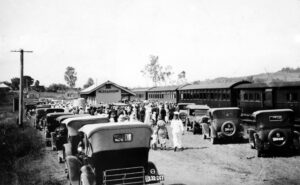

German sailors from the Crusier Karlsruhe arriving at Marburg railway station.
Photos: State Library of Queensland
When the train reached Marburg at 10.10 a.m., the sailors received a spontaneous welcome, an atmosphere which prevailed throughout the whole day. It was said to have been the biggest thrill that the fine old German pioneers had in their seventy years’ residence in the Scrub.
A reporter from the Queensland Times wrote.:
The fact that these sailors are racially one with them and that they are visitors to a new country which has a small settlement of their kinsmen, waives all introduction and preliminaries. They meet on more or less common ground and the one great barrier of intercourse, language, is absent.
The local reception committee consisted of Messrs. William Cooper (chairman), Franz Bielefeld (secretary). H. Sakszewski, J. C. Holzwart, and C. Littmann. Hundreds of local residents gathered and they all marched to the nearby show hall to the German soldier’s songs.
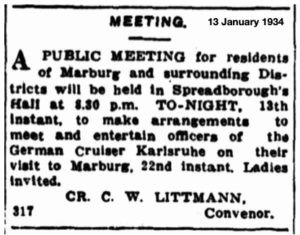 There were five German officers with Lieutenant Smidt in charge. The others were Engineer, Lieutenant Schmidt-Falbe, Surgeon, Lieutenant Dr. Busch, Sub-Lieutenant Fromme and Sub-Lieutenant Bachmann. Four petty officers, 21 non-commissioned officers and 90 men of the rank and file accompanied them. A dinner was given to the visitors at the hall.
There were five German officers with Lieutenant Smidt in charge. The others were Engineer, Lieutenant Schmidt-Falbe, Surgeon, Lieutenant Dr. Busch, Sub-Lieutenant Fromme and Sub-Lieutenant Bachmann. Four petty officers, 21 non-commissioned officers and 90 men of the rank and file accompanied them. A dinner was given to the visitors at the hall.
Mr. Cooper welcomed the guests in English, and Rev. Pastor L. Doehler (Lowood) did so in German. Mr. Cooper mentioned that about 80 per cent of the population of the Marburg district was German or of German descent. He said they were known as law-abiding citizens.
Mr. Hermann Friedrich Sakzewski, an old pioneer, added a welcome in German and recalled pioneering days.
Councillor Littmann asked Lieutenant Smidt to take a message home; that the people of Marburg still remembered their old homeland with pride.
Mr. Edmund B. Maher M.L.A. spoke on behalf of the British residents and praised the work done by the German pioneers in settling their fertile districts.
The Mayor of Ipswich, Alderman A.T. Stephenson said the German pioneers had suffered privations to make the Marburg district so fertile.
Lieutenant Smidt responded in German and told the people about the present day Germany. At his instigation, a toast to the reception committee was honoured musically and accompanied by the Nazi salute.
The sailors were young men between the ages of 18 and 24. The officers weren’t much older and they were all in a care-free holiday spirit. Everywhere they could be observed engaging in pleasant meetings and responding wholeheartedly to the attentions of their hosts.
After dinner some of the sailors went on a “horseback cruise” around the area but most were driven around by car. The fertile surroundings of Marburg gave the visitors a fair insight into the working of farms and how the German industry and perserverance had transformed a dense scrub in to such a beautiful district.
Before the sailors left by train they gave three “Hurrahs” in acknowledgment of their welcome.
Kalbar’s welcome:- Thirty sailors from the Karlsruhe were enthusiastically welcomed on their arrival at Roadvale. Pastor Finger presided at a gathering in the School of Arts, and Councillor Wendorf spoke. The visitors were conveyed by cars to the Kalbar Lutheran Church where a banquet was given. Councillor Pennell welcomed the visitors, and Lieutenant C. Von Steinberg responded.
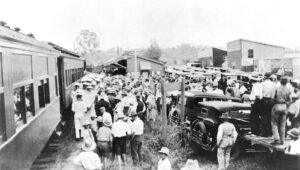
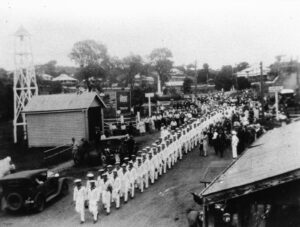
Arrival at Boonah Railway Station (top photo) and the crew of the Karlsruhe marching through Boonah.
Photos: State Library of Queensland
At Boonah the residents welcomed the train carrying 100 German officers and rank and file at 10.40a.m.. The number included the ship’s band. Commander Baron Harsdorf von Enderndorf, accompanied by the ship’s chaplain Schallehn, arrived by motor from Brisbane with Mr. Berkmayer, President of Deutscher Turn-Verein, Brisbane. (The trio went to Marburg after the welcome here.)
They were met by about 400 people at the Boonah station. Many of these residents had sent their sons away to fight the German force during the Great War, yet the former enemies were enthusiastically welcomed as if they were their own sons.
Captain von Enderndorf and the ship’s band led the march through the main street to the war memorial shrine, where a two minutes’ silence was observed.

Pastor Hiller welcomed the visitors and said, “The German nation has suffered since the war, but there has been a re-birth in Germany. All sections of the community have been brought together with a great man at the head – a man of sterling and Christian qualities. Herr Adolf Hitler has been given almost dictatorial powers, and he is applying them in a conscientious manner.”
Councillor W. Farley (chairman of the Goolman Shire Council) presided at the civic welcome. Mr. A. Wienholt, M.L.A., spoke and Major B. C. Bell welcomed the visitors on behalf of the returned soldiers, contending that it was time that all war thoughts were forgotten.
Captain von Enderndorf said it was gratifying to see the respect in which the German-Australians were held by the Australians of other nationalities.
At the conclusion of the speeches Mrs. Hiller presented the Commander with a young wallaby as a ship’s mascot. They named it “Boonah”.
Also on that day, Herbert Moreton Olm of Ropeley, presented the Commander with a jig-saw puzzle of Australia in a frame he had made himself. Herbert later received an etching of the Karlsruhe from the Commander. It was signed by him and six of the chief officers of the cruiser and was accompanied by a letter of thanks. It said, “I am very delighted seeing this map, and I shall never forget the most pleasant time spent in Brisbane.”
The Karlsruhe left the Mercantile Wharf at Bulimba punctually at 6 o’clock on the morning of the 25th January. About 500 people on the wharf gave it a rousing farewell. She headed off for Samoa and Honolulu before returning to Germany via the Panama Canal.
In February, she ran into a typhoon near Samoa and several of the crew were injured. Many people questioned whether this was the same cyclone that crossed the Pacific Ocean and eventually struck the Queensland coast near Mossman in March, accounting for the loss of many lives there.
At the same time as the Karlsruhe was bringing a message of peace, Adolf Hitler was jay-walking across Europe. In August 1934, Hitler became Führer, absolute dictator of Germany, and the rest is history.
I’d give a penny for the thoughts of those Queenslanders and the sailors from the Karlsruhe, who heard all of those speeches and so willingly extended their hands in friendship, when just five years later they were once again, at war.
The commander of the ship was asked to collect animals from countries the ship visited. The animals were destined for a zoo in the city of Karlsruhe. These included a kangaroo, monkey, bear and a leopard. The leopard’s mother was shot by a British officer and he gave the cub to ship’s physician. However the leopard, named “Trinco” by the crew, died the day before the ship arrived back in Kiel.

Kangaroo on board the German warship ‘Karlsruhe’, 1934
Photo: State Library of Queensland
© Jane Schy, 2024
